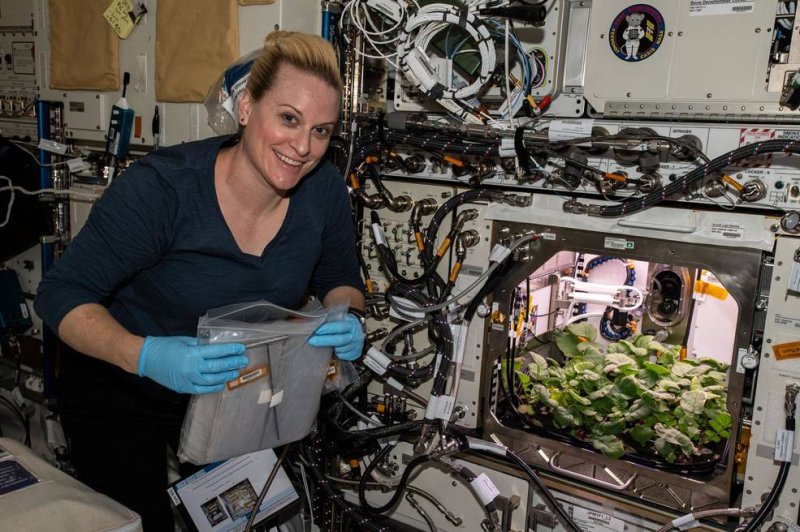
Astronaut Kate Rubins harvests radishes in December aboard the International Space Station. File Photo courtesy of NASA
ORLANDO, Fla. Oct. 22 (UPI) -- NASA has chosen 18 companies to continue developing space food that astronauts could eat on long-term, Deep Space missions to Mars or other planets, such as 3D-printed steak and ingredients including insect protein, fungus and algae.
The space agency believes its ongoing Deep Space Food Challenge is vital to keeping astronauts healthy and in good spirits during long isolation. NASA announced this week that more than a dozen organizations will receive $25,000 to keep working on space food solutions.
NASA has tried to focus on appetizing solutions for astronauts, but it also believes innovation requires new approaches, Ralph Fritsche, NASA senior project manager for space crop production, said in an interview.
He said about 10 NASA employees with expertise in food production and spaceflight judged the contest, which had more than 100 entries.
RELATED NASA will pay $500,000 for good ideas on food production in space
"These ideas didn't have to be anywhere close to fully developed," Fritshe said. "Some of our judges may have had some skepticism. But we've decided to open up space food development to many other groups to try and promote space innovation."
The 3D-printed space steak, for example, is proposed by an alliance of companies based in California known as Mission: Space Food.

A 3D-printed steak, which could provide food for astronauts on long missions, is cooked by Aleph Farms in February. Photo courtesy of Aleph Farms
One of those firms is Aleph Farms, which successfully printed a facsimile of a rib-eye steak in February. Aleph boasts advisory board members such as Academy Award-winning actor Leonardo DiCaprio and retired astronaut Karen Nyberg.
"As we progress in human exploration and colonization of our solar system, space agencies and private companies will need to invest significantly in ... food production so eating in space can minimally depend on resupply from Earth," Shahreen Reza, co-founder of Mission: Space Food, said in an email.
Judges didn't see anything completely new in the ideas for space food, Fritsche said. NASA has grown leafy greens, radishes and peppers in space, for example.
But some entries "moved the bar, pushed the variety of food that we could produce from any single system" by including fungus and algae along with traditional plant crops, he said.
RELATED Astronaut Kate Rubins: Fresh food in space is rare, desired

Mixed greens grow aboard the International Space Station. Photo courtesy of NASA | License Photo

Radishes are shown during harvest in late 2020 aboard the International Space Station. Photo courtesy of NASA
The idea to mix fungus, algae and plants came from Cosmic Eats, a startup company in Cary, N.C.
"Variety is very important on a long space journey, so anything that adds to variety is a big plus," Fritsche said.
One firm, Beehex, of Columbus, Ohio, won with a simple proposal to dehydrate and hermetically seal food so it could be rehydrated with flavor and nutrients intact up to five years later.
Winners from this year's competition will advance to successively narrower and more difficult challenges. Eventually, NASA will require kitchen demonstrations, taste tests and possible demonstrations on orbit.
"Variety is very important on a long space journey, so anything that adds to variety is a big plus," Fritsche said.
One firm, Beehex, of Columbus, Ohio, won with a simple proposal to dehydrate and hermetically seal food so it could be rehydrated with flavor and nutrients intact up to five years later.
Winners from this year's competition will advance to successively narrower and more difficult challenges. Eventually, NASA will require kitchen demonstrations, taste tests and possible demonstrations on orbit.

NASA astronaut Tim Kopra photographed his breakfast in 2016 as it floated inside the International Space Station, where fresh food is rare. Photo courtesy of NASA | License Photo
Other winners include:
Astra Gastronomy, of San Francisco, which plans to grow and dehydrate fast-growing microalgae to form into "crunchy bite-sized snacks mixed with nuts and other ingredients."
Space Bread, of Hawthorne, Fla., which would develop a plastic bag to allow astronauts to store, combine and bake all bread ingredients for a "ready-to-eat yeast-risen roll."
Deep Space Entomoculture, of Somerville, Mass., which would use cells from insect tissue to grow more tissue so the final product would contain protein and fat from insect cells.
The goal of the so-called entomoculture project is "to create familiar meat analogs (burgers, ground meat) using [insect cells] that are more easily adapted to growth in space" than common meat would be, Sophie Letcher, a biomedical engineering doctoral student at Massachusetts-based Tufts University, said in an email.
NASA plans a livestream broadcast on its YouTube channel about the food challenge and the winning ideas with celebrities Martha Stewart and retired astronaut Scott Kelly on Nov. 9 at 11 a.m. EST.

NASA astronaut Scott Kelly corrals a supply of fresh fruit that arrived 2015 at the International Space Station, where fresh food is rare and delivered only occasionally. Photo courtesy of NASA
No comments:
Post a Comment